Guinea growers and growing on. A Guineas teenage years.
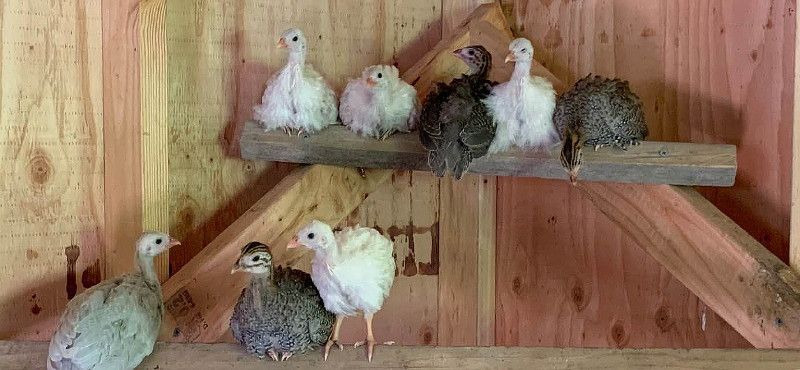
Guinea fowl growers need careful handling, feeding and training if you want to get the best out of them in the years to come. Guineas are classed as growers between 6 and 16 weeks of age.
The difficult teenage years of Guinea fowl.
Or how to stop Guineas just buggering off when you let them out!
Definitely it is easier to start with young Guinea fowl chicks or keets .
Older guinea fowl will often leave as soon as you turn them loose for no apparent reason at all. You need to train them, which is difficult but not impossible, if you are willing to take the time.
Hatch your own or start with day old keets if possible. If you want to give your keets the best chance to learn your ways.
Below: A Guinea grower, almost fully feathered.
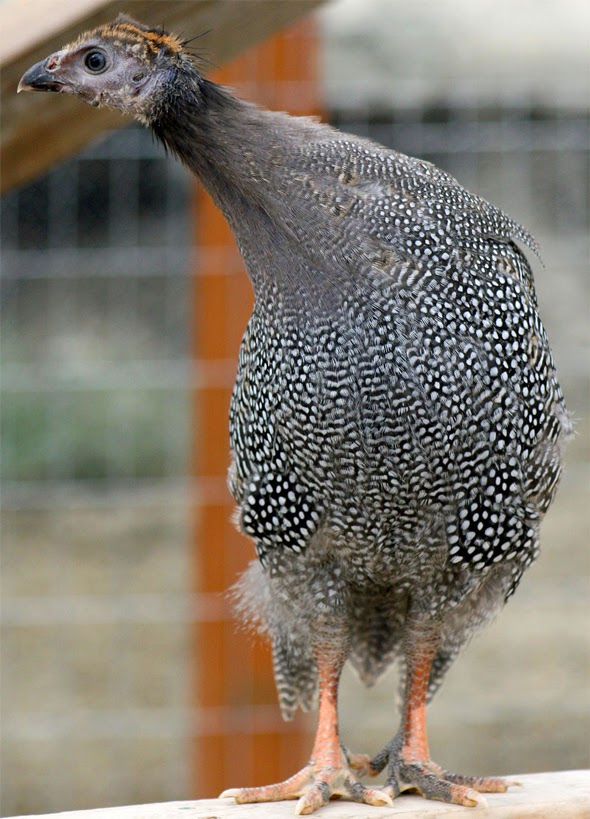
Although I do breed my own colours, my free range egg flock of Guineas are all pinioned by the supplier before they are delivered. Before this I lost 1 or 2 in 10 to them just upping and leaving.
Six is really the smallest number you should start with and 30 is the maximum. They do best in small group with a single male and 29 others is the most a guinea brain can cope with.
You need to spend much more time with guinea chicks than with chicken youngsters. They are more difficult to reach and quick movements will send them off in a flash of panic. Guineas need to be ready to make any move, they cannot be forced or even, for the most part, tempted.
What is the easiest way to raise Guineas?
The easiest way by far is with a broody hen, they do the hatching, keep the little ones in line and if the hen is a particularly friendly one and you are well associated with food and treats then the guinea keets will follow her lead.
Below: By far the easiest way to raise Guinea fowl is with a broody chicken.
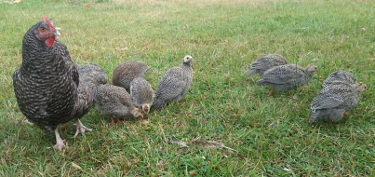
The keets will learn she is the warmth source and the teacher when it comes to feed and will often follow a hen around long after chicks would have fledged and left. They will also roost with her and learn to use the coop and if this habit is formed during their early years it seems to persist their whole life.
My Guineas are always raised under a broody hen and they even come running when the hens do for treats so it is possible to have them behave somewhat like chickens.
The next easiest way is with your care and handling in a brooder and then on to a nursery pen with the adults or the adult run so as they can get used to their final environment. Whereas with chickens this process would take at most 4 days with guineas it can take 4 to 6 weeks.
I have tried the manual way in the past and it is just too much work for the keeper.
Feeding Guinea fowl growers.
Guineas are happier to find the greater portion of their feed on their own but they do like grains and grass. These should be available in the afternoon or early evening at the location you want the Guinea fowl to return to.
Feed them turkey or game fowl starter for the first six to eight weeks and then grower ration medicated with Amprolium to keep coccicidia under control for for the higher protein content. I always feed medicated to start with but appreciate that it is a personal choice.
Feed a grower ration from 8 week till at least 12 and then begin to introduce grains into the diet.
Later, when set free, Guineas on range will consume mostly bugs and seeds. Mine like grains and sprouts but never really the touch layers pellets.
Guineas will eat more feed in the winter when the snow covered ground hides a lot from them.
Below: You can see my Guineas feeding on scratch grains with my hens quite happily.
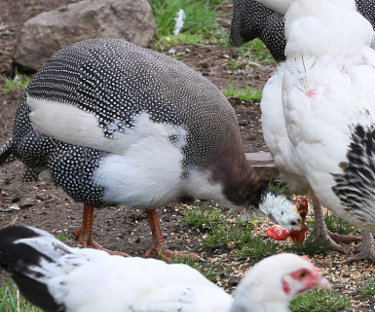
Grit should be on tap for growers but not shell, they don't need the extra calcium until the begin to lay.
Once in the hen house, the Guineas are able to eat whatever I feed the chickens. My adult chickens are fed commercial pellets and scratch.
Chickens are normally not fed the higher protein turkey feed and the lack of colour additives in Turkey feed makes the Guinea fowl yolks very pale.
If you have Guineas only in your hen house, you can feed a game bird ration. When old enough to free range, the adult Guinea fowl diet consists of 90% bugs, grazing, scratch and seeds.
Guinea fowl prefer fresh clean cold water that is not in the sun. They can use drinkers but prefer open water.
The big move from the brooder to the coop:
Moving keets can be a frustrating experience. if you plan to use a cat box or something similar then introduce them to it in their own time at least a week before. Place it where they can see it and then a couple of days later open it and let them investigate as they are ready.
Below: Young Guineas getting used to coop. You can see they are perching on the walls. Guinea fowl take 4 to 6 times longer than chickens to get used to their coop!
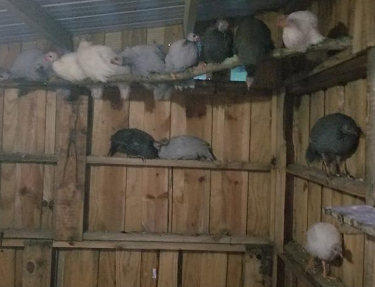
When big enough to leave the brooder mine are moved into the hen house. If they are with a hen she is just moved back in with the group and the keets follow her
I also have a nursery pen next to the main chicken run where growing keets will be kept for at least 6 weeks to get used to the other birds.
At the end of this I open the door to the run and when they are ready they come out to investigate. Keep the coop and run closed at this stage, it will take a little more time of them flying around the run and generally making a nuisance of themselves honking at things until it settles down.
At first the growers will likely try flying up to the roosts looking round nesting boxes a poking their heads through whatever holes they can find and hopefully go back to their nursery pen at night.
If you are lucky they will roost immediately with the big birds but in my experience this takes a few more weeks. Once one starts they generally all go in a day or two.
They will eventually go outside and after a few days will go out in groups on their own. Mine are pinioned so are effectively confined to a 4 acre field. The breeding groups are confined in covered runs.
Fences mean nothing to guineas and they will need to run head first into quite a few until they realise what they are and that they need to go over them.
They need the protection of the building for weather extremes and safety from predators.
Guinea fowl really like to look at themselves, it might be a safety in numbers thing as I doubt they are self aware but a mirror will work wonders for keeping them amused for ages.
Chickens scratch and are destructive to plants and gardens, Guineas much less so but they will still squash plants under their feet and root around for interesting things. Use mulch or gravel to cover your flower beds as a communal Guinea Fowl dust bath will make big holes.
